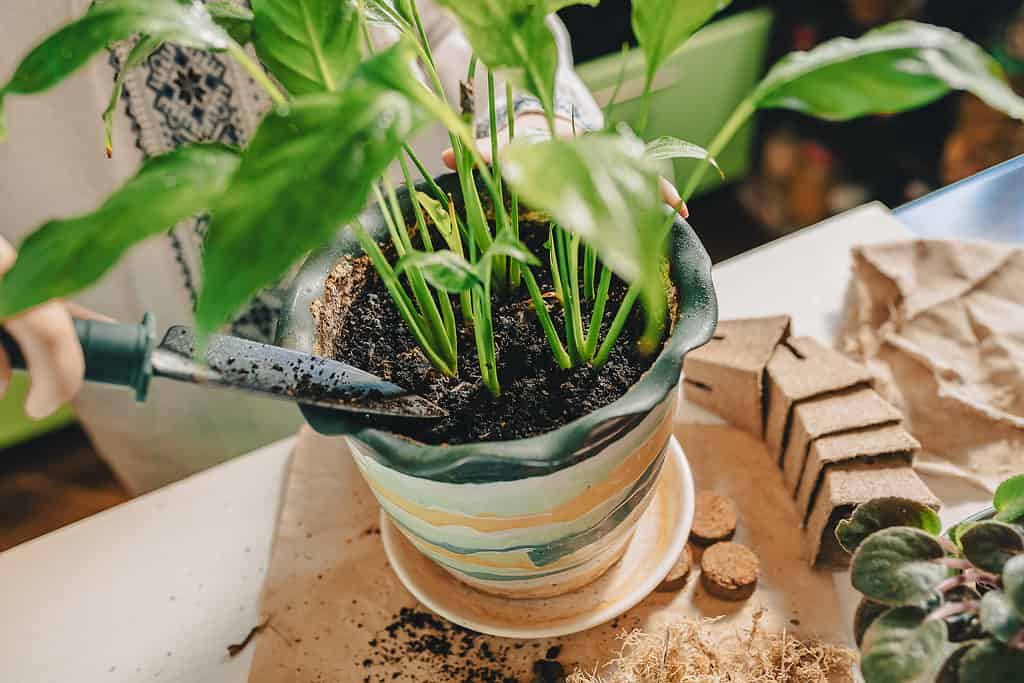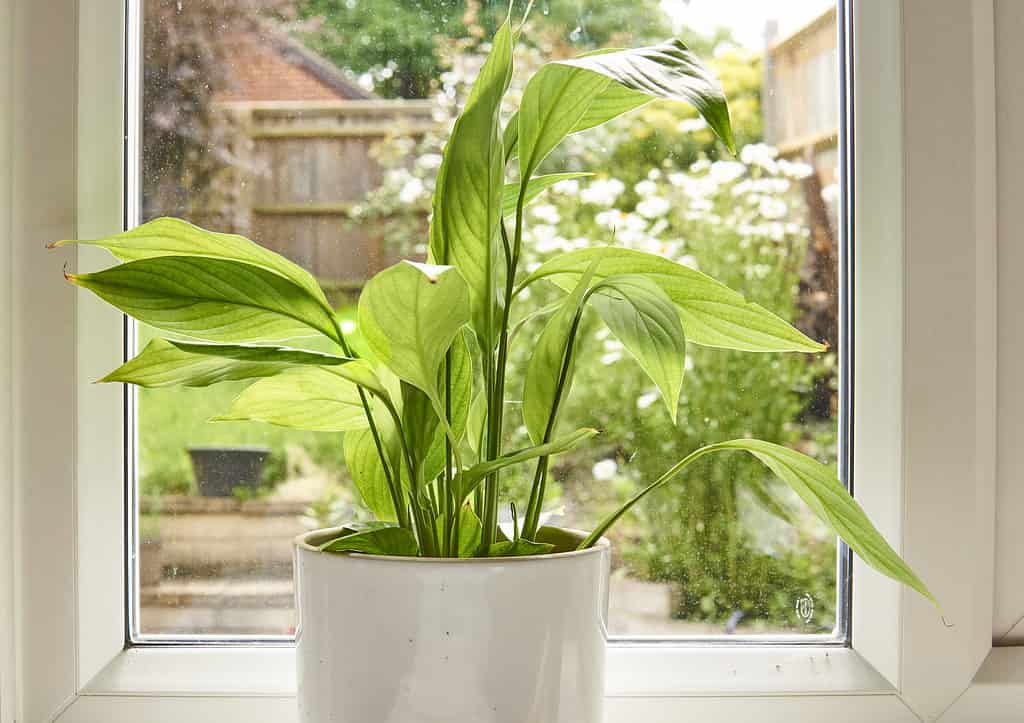Did you know that peace lily “flowers” aren’t exactly flowers at all? The spathes, which resemble white blossoms, are what distinguish peace lilies from other plants despite their unquestionably lovely foliage. The little yellow buds within the spathes are the actual flowers. There are a ton of houseplants available that have unique leaves, but very few of them resemble flowers. Therefore, it makes only sense that you would want to ensure that your peace lily blooms!
A peace lily may not blossom for a variety of reasons, which can make resolving the issue difficult. In this guide, we’ll break down everything you need to know about peace lily flowers, their spathes, common blooming issues, and a few other neat facts about peace lilies.
Do Peace Lilies Bloom?
The peace lily is a tropical and evergreen plant that is known for flourishing on the forest floor where they get indirect sunshine under tree canopies, consistent humidity, and nutritious soil. The secret to getting your peace lily to be content and healthy is to duplicate similar circumstances in your home.
Peace lilies begin to produce white spathes and yellow blooms in the early summer with sufficient light and can bloom all year long with the correct circumstances. It persists for at least a month before dying and fading, at least for most species and varieties. A peace lily doesn’t bloom until it is fully grown and at the mature stage of its life. However, a lot of expert gardeners are aware of how to force a peace lily plant to bloom. To get the plant to start producing, they employ a natural plant hormone called gibberellic acid.
That being said, you definitely do not need to use plant hormones or other extreme measures to get your peace lily to bloom. Rather, your plant will simply need to be in ideal conditions to eventually bloom and look its best. There are a few roadblocks that can prevent your peace lily from blooming, and tackling those roadblocks can be difficult, but they are not impossible to resolve.

Potted peace lilies (pictured) may struggle to bloom if their soil is not fertilized.
©iStock.com/Larisa Stefanuyk
Why Isn’t My Peace Lily Blooming?
Central America is where the majority of peace lilies are found. They flourish in the lush tropical rainforests there. If you wish to keep your plant in optimal shape, you must reproduce these circumstances. Although it can seem a little difficult to do, it is really fairly simple, as long as you tackle some of the common problems associated with not growing a peace lily in the tropics.
Cause: Poor Lighting
Even though the peace lily is quite hardy and will survive in certain unfavorable circumstances, it won’t blossom if the lighting conditions aren’t right. The lighting should always be addressed as the first problem to be solved in order to promote flowering. Lighting issues are among the simplest plant issues to resolve, in many respects.
Peace lilies are often included in lists of houseplants that don’t need much light. It does, however, require enough light to develop and blossom effectively. Your peace lily won’t have the energy to bloom in dim lighting. Although they may survive in lesser light for a while, over time they frequently produce fewer and fewer flowers and may even cease flowering altogether.
In bright, indirect lighting, your peace lily will grow and bloom much more quickly and lavishly. Your plant should be placed next to a window, but out of the direct sun. Sills with a north or west orientation are ideal.
Cause: Lack of Specialized Care and Pruning
Peace lilies, in most cases, begin to bloom during the shorter winter days. The plant sometimes produces blooms in late winter and early spring as the days lengthen. Despite the fact that contemporary varieties can produce flowers for a longer time, your peace lily will still require natural surroundings to grow and finally blossom. You should strive for near perfection in terms of lighting, humidity, temperature, soil quality, and watering practices in order to get your peace lily to bloom during the time period when it naturally tends to bloom.
It should be emphasized that the peace lily’s blossoms are really tiny, inconsequential blooms dispersed around the spadix, which is the stick-like protrusion assumed to represent the flower’s center. Once you’ve found the perfect spot for your plant and it begins to cheerfully produce blossoms, you should routinely deadhead this part of the plant to promote new blooms.
Cause: Lack of Nutritious Soil
Regular feedings of a balanced, water-soluble home plant food are necessary for peace lilies. A plant won’t blossom if there are insufficient nutrients accessible to it. This may occur if your peace lily hasn’t been potted in a while or if you hardly ever fertilize it.
Find a fertilizer with a nutritional value of 20% nitrogen, 20% phosphorous, and 20% potassium. This will promote robust development over the entire plant. If you choose a fertilizer that has an excessive amount of nitrogen, it will promote leaf growth at the price of flowers. After fertilizing your plant, make sure to water it well so that the fertilizer can reach all of the roots.

Peace lilies (pictured) tend to have an easier time blooming in proper lighting and temperature conditions.
©iStock.com/Anya Why
How to Get a Peace Lily to Bloom
In the above section, we outlined a few scenarios in which your peace lily may not bloom, such as poor lighting, not fertilizing your potting soil, and not deadheading or providing specialized care. We’ve outlined potential solutions for those issues, but there are also additional ways to get your peace lily to bloom.
To start, take a look at your peace lily’s soil. Like other houseplants, peace lilies require light, airy, well-draining soil to grow. They do like damp soil, but it should never be waterlogged to avoid root rot. Your peace lily will grow well in the majority of houseplant soil mixtures, but you may also create your own by mixing together two parts of potting soil, one part perlite, and one part of coconut coir. Add one part compost or water-retentive crystals to the mixture for peace lilies in sunnier environments.
You should also examine the container or pot as well as the soil. Although peace lilies prefer having part of their root space constricted, it’s better to repot them if you notice roots emerging from the drainage holes at the bottom.
You should also examine the temperature conditions around your plant if it is refusing to flower. As we previously noted, the peace lily is native to the Americas, particularly Central America, and thrives beneath trees in deep tropical forests. The plants will usually blossom well in this warm climate. To promote flowering, you must replicate the tropical environment in your house. The ideal temperature range for blooming is between 65 and 85 degrees F, preferably higher. Additionally, a high humidity level will mimic the tropical climate that these plants like. They should not be exposed to cold air vents or air conditioners since they do not perform well in drafts.
And, as always, ensure that your peace lily is properly watered. Once a week is the general rule of thumb. Be sure to avoid overwatering and underwatering. Signs of either include a lack of flowers but also include drooping or browning leaves.
Peace Lily Flower Toxicity
Believe it or not, one of the most frequent domestic plants for which Poison Control is contacted is the peace lily. The peace lily has very tiny, insoluble calcium oxalate crystals in its petals, leaves, and stems that, if eaten or ingested, can immediately irritate the mouth and throat. Any fragment of a lily that is consumed may result in instant irritation and even injury to the mouth. Ingestion or chewing on this plant may cause swelling of the lips, coughing, nausea, and vomiting.
Be careful to gently wipe out the mouth of anyone who has eaten or ingested a piece of a peace lily plant, assist them in rinsing their mouth with water, and immediately dial your local Poison Control center. As a general rule of thumb, do not keep peace lilies in homes with small children or pets, or keep them very far out of reach.
When peace lilies do bloom, they can really make the plant the center focus of the room. With a little tender loving care, you can get your peace lily to bloom and maintain its lovely appearance for years to come.
Want to learn even more about this amazing plant? Check out our complete guide to peace lilies here.
Up Next:
- Toxic Plants For Cats
- Discover 10 Resilient Plants That Can Thrive in a Desert
- Are Lilies Poisonous To Dogs Or Cats?
The photo featured at the top of this post is © iStock.com/Galina Tolochko
Sources
- NCSU Staff, Available here: https://plants.ces.ncsu.edu/plants/spathiphyllum/
- Daniel Iseli, Available here: https://plantophiles.com/plant-care/peace-lily/
- Kristine Lofgren, Available here: https://gardenerspath.com/plants/houseplants/peace-lily-not-blooming/
FAQs (Frequently Asked Questions)
Can peace lilies grow flowers?
Yes, peace lilies grow beautiful white singular flowers.
What happens to a peace lily plant after it blooms?
After a peace lily produces its flower, the flower will slowly die along with the stalk it grew on.
When do peace lilies flower?
Peace lilies typically flower around spring.
Thank you for reading! Have some feedback for us? Contact the AZ Animals editorial team.






